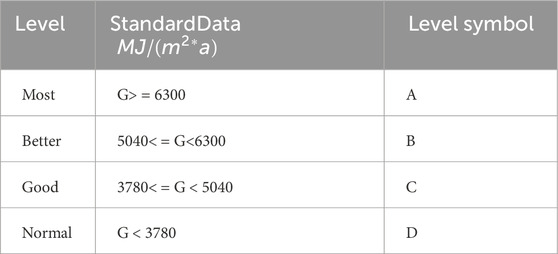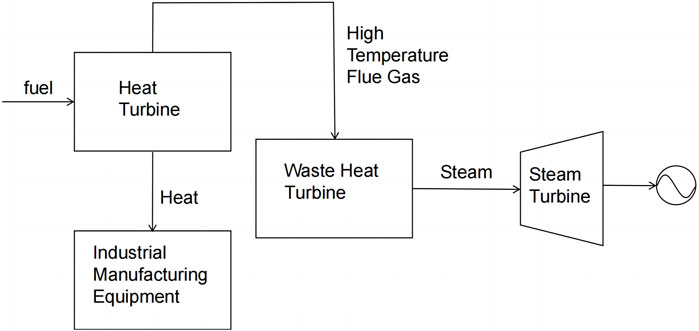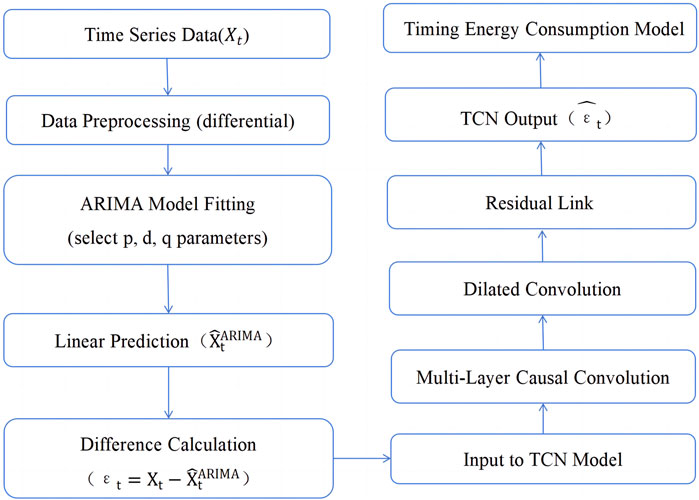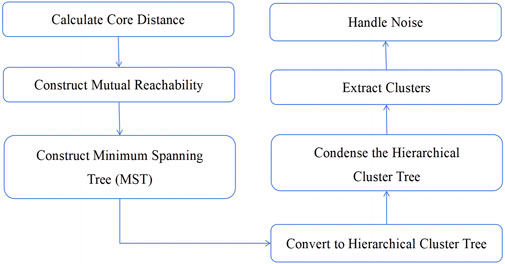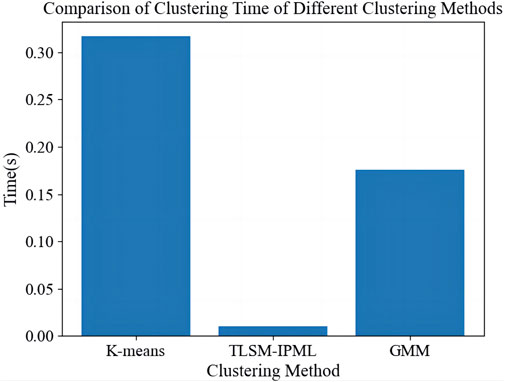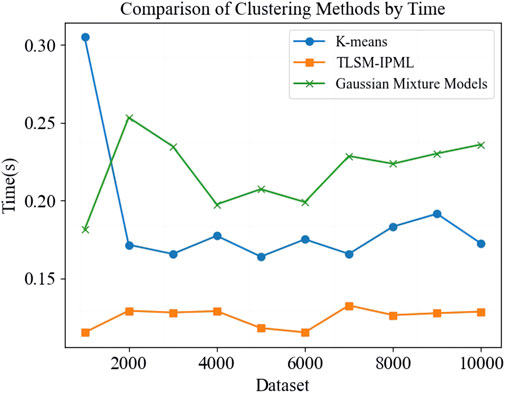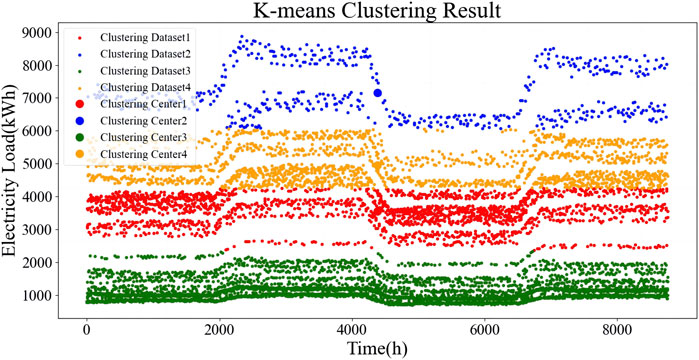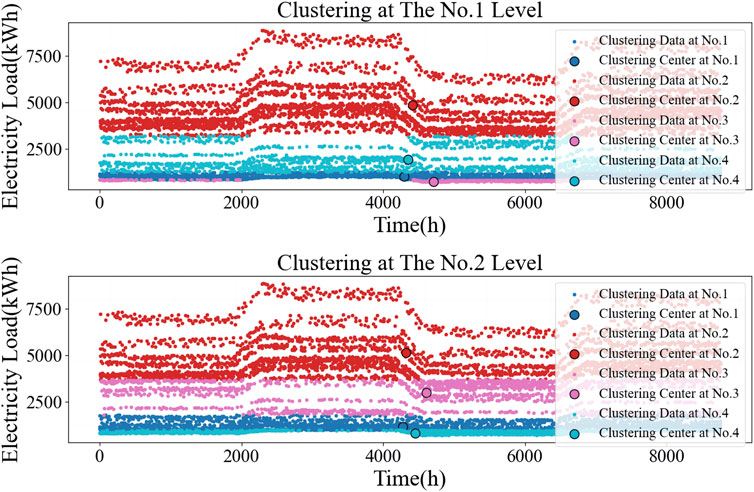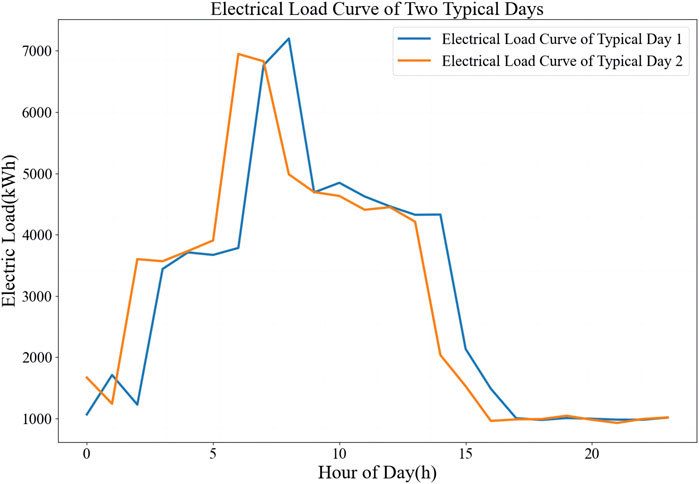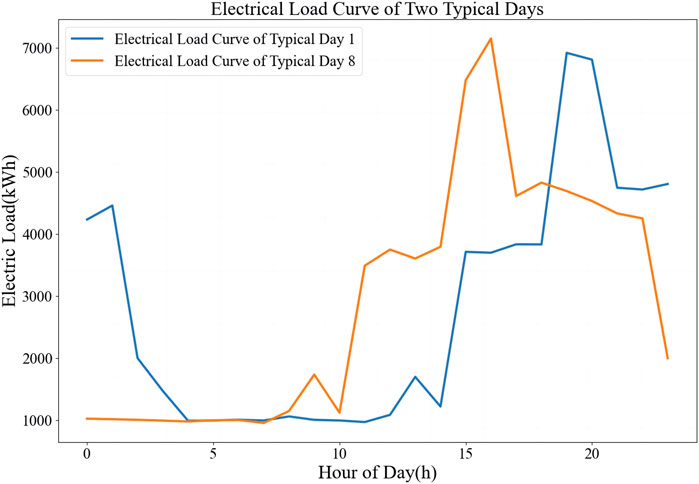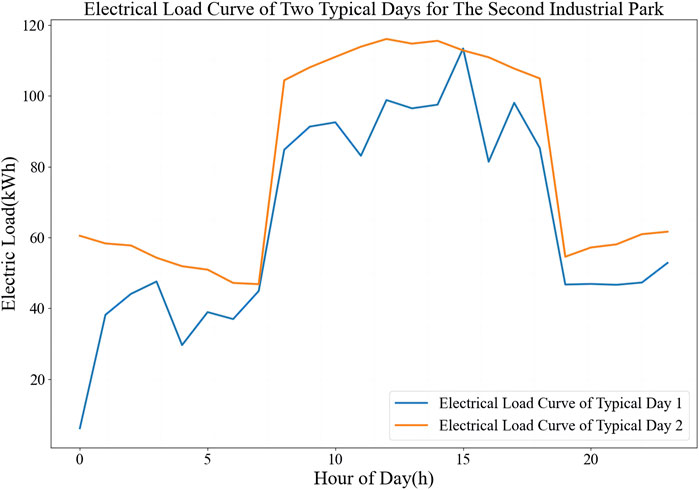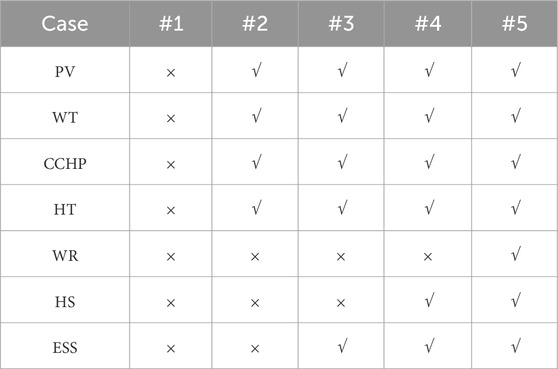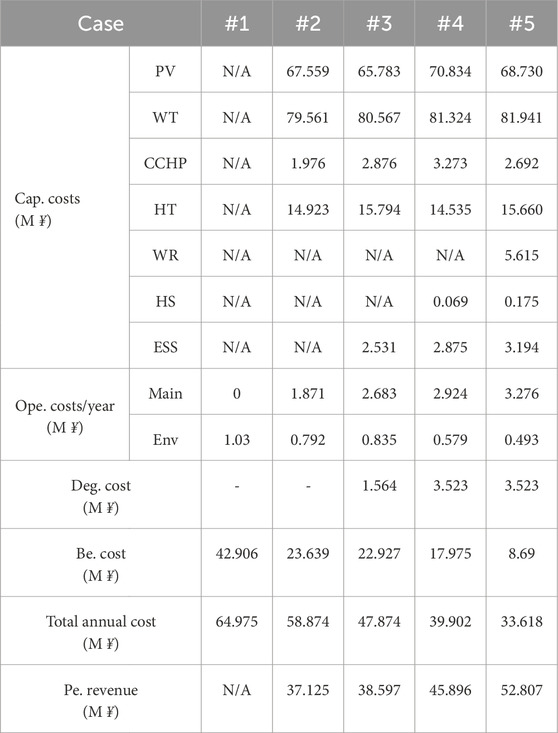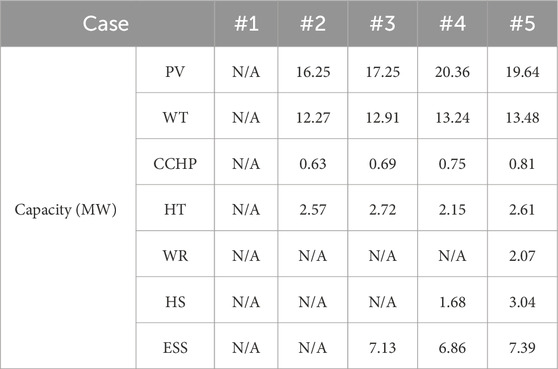- 1Department of Electrical Engineering, Shanghai University of Electric Power, Shanghai, China
- 2Department of Electrical Engineering, Chongqing University, Chongqing, China
- 3Dongfang Electric Group Dongfang Electric Motor Co., Ltd., Sichuan, China
This paper intends to provide key insights to the manufacturing industrial park designers for selecting the typical days of electric load and planning the resources for energy-producing infrastructure. First, a hybrid time-series model of energy-consuming equipment based on the autoregressive integral moving average model (ARIMA) and temporal convolutional network (TCN) is generated. According to this model, the energy consumption (EC) curve of large equipment in the industrial park can be depicted. Moreover, the present study designed a TLSM-IPML (typical load stratification method for industrial parks with manufacturing load) algorithm based on the typical day-selected method. The data clustering method is utilized to analyze the energy usage characteristics. Furthermore, an energy usage-based planning model is proposed, network constraints are considered, and a multi-optional method is designed to solve the problem. Finally, case studies validate the superior performance of TLSM-IPML in analyzing the characteristics of energy consumption and planning the model in reducing MES (manufacturing industrial factory integrated energy system) economic costs.
1 Introduction
With the evolution of energy infrastructure, integrated energy systems (IES) have been developed to improve efficiency and lower carbon emissions. The electrical systems in industrial parks, especially heavy equipment manufacturing, face challenges due to variable energy consumption, high peak loads, and operational schedules (Shao et al., 2023; Lv et al., 2020). Maintaining power quality is critical to prevent disruptions, but the long-term effects on equipment and efficiency are underexplored (Araghian et al., 2023; Zhong et al., 2018). Integrating renewable energy is essential for reducing emissions, yet the economic feasibility and optimization of large-scale integration need more study (Mehrjerdi et al., 2021). Energy storage solutions like batteries are vital for mitigating peak loads and improving system efficiency, but their integration requires further research (Pombo et al., 2023). The evolution of energy infrastructure has led to integrated energy systems (IES) that improve efficiency and lower carbon emissions by supplying heat and electricity simultaneously using the combined cold, heat, and power (CCHP) approach. However, effectively modeling large-scale equipment in industrial parks remains challenging. To address this, a template-based load modeling technique is developed for a better representation of industrial energy consumption within an IES. Overall, advanced strategies are needed to predict and manage energy fluctuations, optimize load distribution, maintain power quality, integrate renewable energy, and enhance storage solutions, addressing gaps in current research and practice.
To gain insights into users’ electricity consumption behaviors, data clustering algorithms are utilized to analyze load data. Density-based clustering algorithms like DBSCAN (Fang et al., 2023) are popular for identifying dense regions and measuring point density. Despite its effectiveness (Fan et al., 2019), DBSCAN’s performance is highly sensitive to parameters like neighborhood radius and minimum points. OPTICS (Mahran and Mahar, 2008) extends DBSCAN to handle varying densities but has a high computational cost. DPeak and its variants (Muja and Lowe, 2014; Cheng et al., 2021) identify density peaks for non-convex clusters but require complex parameter tuning. The mean shift (Fan et al., 2017) shifts points toward higher densities, converging at local maxima without predefined cluster numbers, but struggles with high-dimensional data due to computational expense. DCore (Chen et al., 2018) improves core point identification but involves intricate parameter settings. These methods face challenges such as parameter sensitivity and computational complexity, limiting their effectiveness on large-scale data. For instance, K-means has a complexity of
Recent studies have constructed renewable energy models for new-energy park planning, but handling the complexity of grid connections for renewable energy is challenging. Non-linearity and modeling complexity often lead to overlooked constraints in the internal energy network and operational uncertainties. Martinez Cesena and Mancarella (2019) proposed a robust operational optimization framework for smart districts with multi-energy devices and integrated energy networks (Rhodes et al., 2014). Building on this, Good and Mancarella (2019) considered network constraints for IES planning yet faced challenges in engineering applications due to neglecting the non-linearity of hub equipment. Clegg and Mancarella (2016) addressed these difficulties by introducing a unified energy flow model with refined device models. Despite demonstrating the coupling model of integrated energy systems (IES), the increased system scale complicates computation and convergence. To address this, Zhao et al. (2021) developed a decomposed method for the IES under grid-connected modes, and Zhang et al. (2021) extended this to combine heat, gas, and electric systems for better computational performance. Improving hydrogen production efficiency via electrolysis is also a key focus, with studies like Fu et al. (2020) and Li et al. (2019) exploring the impact of electrolyzer sizes, system efficiencies, and optimal dispatch models. However, these studies often face issues such as ignoring the temporal dynamics of equipment energy use, failing to select typical load days effectively, and lacking a comprehensive analysis of operation and maintenance costs. These gaps highlight the need for efficient and scalable solutions in integrated energy management.
In distribution system planning, the total cost depends on the efficient use of renewable distributed generation, related to network capacity and system loading levels. Demand controllability and connections with renewable generation also impact optimal energy infrastructure distribution. However, existing studies often overlook the temporal dynamics of large equipment energy use, which is critical for accurate energy planning and optimization. This paper proposes a novel time-series energy consumption (EC) model and uses clustering methods to select typical days for load analysis, better analyzing the EC and load characteristics of manufacturing industrial parks. Additionally, the operation and maintenance costs of large-scale energy-consuming equipment and their benefits are considered, emphasizing their role in the park’s overall objective function. The existing literature falls short in the following ways: 1) it ignores equipment temporal dynamics, 2) fails to effectively select typical load days, and 3) lacks a comprehensive analysis of operation and maintenance costs. The main contributions of this paper are as follows:
• First, a hybrid time-series model of energy-consuming equipment based on the autoregressive integral moving average model (ARIMA) and temporal convolutional network (TCN) is generated. According to this model, the EC curve of large equipment in the industrial park can be depicted.
• Second, in this paper, a load clustering method based on the TLSM-IPML algorithm is proposed for selecting typical days of electrical loads in manufacturing industrial parks. The impact of energy use behavior on the planning results is revealed.
• Third, a maintenance model is proposed to analyze the adaptive maintenance of energy-consuming equipment. Moreover, this paper suggests a manufacturing industrial integrated energy system (MES) planning model considering the load characteristics to minimize the total cost, including investment in facilities, operation, purchase energy costs, and benefits from energy production.
The rest of this paper is as follows: The industrial park’s renewable energy models and large types of equipment are introduced in Section 2. The load clustering method based on the TLSM-IPML algorithm is introduced, and the clustering efficiency of different clustering methods is comparatively analyzed in Section 3. The objective and restriction functions are proposed in Section 4. Section 5 shows the solution method of the planning model. In addition, the case studies are given in Section 6. Last, conclusions are drawn in Section 7.
2 Representation of system generation and energy-consuming equipment
This section introduces the MES model with nonlinear power and gas flow equations, including the resource endowment assessment, renewable energy equipment models, and ESS model. Furthermore, a mathematical model of EC equipment is built to conduct EC analysis.
2.1 Energy-supplying equipment
In this section, models of the energy equipment are shown. The structure of the IES contains the following parts: the photovoltaic power generation model, wind power generation model, and HP model.
2.1.1 Photovoltaic power generation model
Solar energy is a clean and abundant resource. Estimating solar energy resources involves evaluating total solar radiation. This parameter is compared with standard data to determine solar energy levels, as shown in Table 1, Total solar radiation is the sum of direct and scattered radiation.
After understanding the level of solar energy resources, photovoltaic power generation equipment will be deployed. The output power of photovoltaic power generation equipment is mainly related to the light intensity, operating conditions, and ambient temperature received by the photovoltaic array. The relationship between radiation intensity and the output power of a PV module is described by a linear function.
2.1.2 Wind turbine
To plan a new energy park, the wind energy potential of the location must be assessed before design. The two-parameter Weibull distribution is widely used for analyzing wind speed. Wind energy potential is typically assessed using wind velocity and wind power density data (Chauhan and Saini, 2014).
After the data of
The wind speed mainly determines the output power of the wind turbine generator. Figure 1 shows the wind speed power function of the wind turbine generator. When
2.1.3 CCHP turbine
Combined cooling, heating, and power (CCHP) systems generate electricity, heat, and cooling from one source, such as natural gas. A prime mover (e.g., gas turbine) produces electrical power (1 MW–10 MW). Waste heat is recovered (600–800
2.1.4 Waste heat recovery system
A waste heat turbine is a waste heat collection device that collects waste heat from the heat pump and CCHP and turns waste heat into high-temperature gas, which can be used in steam turbines for power generation. The physical model of the waste heat recovery system is as follows: the main function of a waste heat boiler is to use waste heat to generate steam. The power generation capacity of the waste heat recovery system is calculated as follows Equation 1:
where
2.1.5 Hydrogen production system
Hydrogen is produced using an electrolyzer system which converts electrical energy into chemical energy using water electrolysis technology. The amount of hydrogen produced from the electrolyzer is directly proportional to the current supplied to the electrolyzer system (Zeng et al., 2014).
The electrolyzer conversion efficiency behavior is crucial for the economic and technical analysis of hydrogen production. By improving the electrolyzer efficiency, the hydrogen production cost can be minimized. The conversion efficiency of the electrolyzer system represents the ratio of the output energy content of the produced hydrogen at the electrolyzer stack to the input DC power energy into the electrolyzer stack (Yodwong et al., 2020).
2.2 Energy storage equipment
Batteries are often used to store surplus PV power and grid power during low grid electricity prices, to be used later when demand exceeds PV power generation and during times of high grid electricity prices. They are already a very mature energy storage technology. The thermal storage tank can store excess heat in it. When there is a heat load demand, the heat in the thermal storage tank can be used for heating, maximizing the energy efficiency of the entire system. For the electricity and heat storage equipment of the integrated energy system, a general model can be used to represent the process of energy accumulation and release, as shown in following Equations 2−6:
where X represents the type of energy, including both P for electricity and H for heat; the subscript x is the energy storage equipment; Bat and Tst are electricity and heat storage, respectively; Etx indicates the energy stored by the energy storage device in period t; δx is the energy self-loss rate of the energy storage equipment; ηch,x and ηdis,x are the energy storage efficiency and energy discharge efficiency of the energy storage equipment, respectively; Xt ch,x and Xt dis,x are the energy charge and discharge power, respectively; uxt is the energy storage and discharge identifier of the energy storage equipment, which is a 0-1 variable; when it is 1, it means that the energy storageequipment is storing energy in period t; ρmax ch,x and ρmax dis,x are the maximum charging and discharging coefficients of the energy storage device, which represent the proportion of the maximum energy storage and discharging power of the energy storage device to the total capacity of the device; SOCmin x and SOCmaxx are the minimum and maximum energy storage ratios of the energy storage device, respectively; EPx is the planned installation capacity of the energy storage device.
2.3 Energy-consuming equipment
In this section, we build detailed energy consumption models for key equipment within the industrial park. The equipment includes air compressors, coil factory ovens, and charging stations. By simulating the energy usage patterns of these devices, we aim to optimize energy management and improve efficiency, providing a framework for effective energy-saving measures and sustainable industrial operations.
2.3.1 Air compressor
Compressing air consumes electricity directly. To model the energy consumption (EC) of an air compressor, key factors include the type, number, operating efficiency, and start–stop times of the compressors. The mathematical model for an air compressor station with
where
2.3.2 Coil branch factory oven
To establish a mathematical model of an oven, the main goal is to describe and predict the temperature distribution, heating time, and EC within the oven. This model can be used to optimize oven operating conditions, improve energy efficiency, and ensure product quality. For unsteady one-dimensional heat conduction, the equation is, as shown in Equation 8:
where
2.3.3 Charging pile
The efficiency of charging piles is affected by many factors, including charging current, voltage stability, impedance of charging lines, and quality of charging equipment. Charging piles will produce certain losses during the charging process, affecting their energy efficiency, including losses during the power conversion process and losses caused by line resistance. Based on the above analysis, the charging pile model is built as follows Equation 9:
where
2.3.4 Construction of the sequential model for large-scale energy-consuming equipment
To analyze the impact of random large-scale energy consumption (EC) in heavy equipment manufacturing industrial parks, the EC and time dependence of energy-consuming equipment should be modeled accurately. This section proposes a general ARIMA model structure to simulate the EC curve, where
where
where
To forecast seasonal and residual components using ARIMA, it is important to ensure that the time series is stationary as this is necessary for building a useful ARIMA model. Stationary series have constant statistical properties over time. The augmented Dickey–Fuller (ADF) test can be used to check for stationarity. If the series is non-stationary, differencing operations should be applied. The process is shown as following Equation 12.
where
where
After the TCN model is built, it can be applied to the EC modeling of large-scale electrical equipment in a heavy equipment manufacturing industrial park. The TCN model combines traditional time-series analysis and deep learning for forecasting. First, the ARIMA model captures the linear trend and periodicity in the data to obtain the basic trend EC. Then, the residuals from the ARIMA model are used as the input for the TCN model to capture nonlinear patterns and long-term dependencies. At this time, the residuals are calculated as
The TCN model uses a self-attention mechanism to effectively capture relevant information in sequence data, improving the accuracy and robustness of EC modeling for large-scale equipment in heavy equipment manufacturing industrial parks. The flowchart of the hybrid ARIMA and TCN model is shown in Figure 3.
Based on the above energy usage patterns of large equipment manufacturing industrial parks, an overall model is built for the energy usage patterns of large equipment in heavy equipment manufacturing industrial parks. Due to equipment wear and energy loss in the production process, the total system EC at time
where
where
In the energy system, energy is lost when converting one form of energy to another, for example, the conversion of fuel to electricity (such as in combustion power plants) or the conversion of electricity to mechanical energy (such as in electric motors). Thus,
where
In the energy system, equipment consumes energy in the standby mode or during low-efficiency operation, for example, the energy consumption of power generation equipment at low load or idle times or household appliances in the standby mode. Thus, the standby EC is given as follows Equation 18:
where
In the energy system, additional energy consumption occurs when adjusting the power output to meet load fluctuations and peak demand, for example, when the power grid starts, backup generators or peaking power plants meet high-demand periods, leading to increased energy consumptions. Thus, the EC of peak load and regulation can be expressed as follows Equation 19:
where
The proposed model for heavy equipment combines ARIMA and TCN to handle linear and non-linear energy consumption patterns. Regular updates to the TCN and dynamic adjustments to the ARIMA ensure that the model remains accurate and responsive to changes. This approach maintains reliability without a complete overhaul when conditions change, making it suitable for evolving operations.
3 TLSM-IPML clustering method
In the previous section, we developed an energy model for the industrial park. This chapter uses TLSM-IPML clustering to select typical days, capturing time-related and seasonal energy consumption patterns. This helps in understanding usage and applying ARIMA and TCN models accurately, improving energy management and efficiency.
3.1 Basic definition and process of the TLSM-IPML clustering method
In this section, the TLSM-IPML clustering method is introduced. The core idea behind TLSM-IPML is to convert the problem of density-based clustering into a problem of finding the areas of high density in the dataset and then hierarchically clustering these dense areas based on their density and separation. It operates on the principle that clusters are areas of higher density than their surroundings in the data space.
3.1.1 Basic ideas of the TLSM-IPML clustering method
As noted in Zhang et al.’s (2023) study, DBSCAN struggles with large-scale data due to its high complexity. Our analysis shows that points
In this article,
where
Using core distance and interconnection distance as measurements is more appropriate. The core mathematical concepts and formulas of the TLSM-IPML algorithm are given as follows:
Core distance: For a given minimum number of samples
Interconnect distance: Interconnect distance is defined based on the core distance and is used to evaluate the reachability between two points. For two points
Minimum spanning tree (MST): Using core distance and reachability distance, a minimum spanning tree on a point set is constructed, where the weight of each edge is the reachability distance.
A single-chain hierarchical clustering process, based on MST and using reachability distance, is applied. Cluster centers are selected through a stability-based method to calculate the sum of reachable distances for each potential cluster, identify clusters that remain stable until distance increases (indicating decreased density), and select clusters by cutting the longest edges to split the tree. Points not meeting stability or size requirements are considered noise. The steps of the TLSM-IPML algorithm are as follows Figure 4:
1) Initially, the dataset is transformed into a graph represented as a minimum spanning tree (MST) and calculated based on the mutual reachability distance between points. This process ensures that the distances are normalized even in datasets with varying densities to reflect the density landscape more accurately.
2) Using the MST, TLSM-IPML constructs a hierarchy of clusters by removing the longest edges first and separating the graph into smaller, denser components. This process resembles finding valleys in a topological landscape, where each valley represents a potential cluster.
3) The algorithm then condenses the hierarchy to remove the less significant branches. This step simplifies the cluster hierarchy, making it easier to analyze and interpret.
4) Finally, TLSM-IPML extracts the clusters from the condensed hierarchy based on their stability. A cluster’s stability is a measure of its persistence over the range of distances considered; more stable clusters are considered significant, while less stable ones are treated as noise.
As shown in Algorithm 1, there are two significant parameters: minimum cluster size (MCS) and minimum sample (MS). First, MCS sets the minimum number of points required for a set to be considered a cluster. For electrical load data in manufacturing parks, selecting an appropriate MCS is crucial, impacting the number and size of identified clusters. Larger MCS values yield fewer but larger, more stable clusters, while smaller values detect more smaller clusters. MCS selection can be guided by initial data exploration or domain expert advice, especially when daily load patterns are similar. In addition, MS determines when a point is considered a core point in the algorithm. Higher MS leads to denser core areas, which is beneficial for identifying noisy data. Adjusting MS is necessary based on dataset characteristics to distinguish major trends from random fluctuations or outliers.
Algorithm 1.TLSM-IPML clustering algorithm.
1: Input: dataset
2: Output: cluster labels for each point in
3: procedure TLSM-IPML(
4: compute core distances for all points
5: compute mutual reachability distances
6: construct MST from mutual reachability distances
7: ExtractClusters(MST)
8: assign cluster labels based on stability
9: procedure
10: procedure ExtractClusters(MST)
11: initialize cluster hierarchy
12: while MST is not empty do
13: remove longest edge
14: form two new clusters by splitting at
15: compute stability of new clusters
16: update hierarchy
17: while
18: return
19: procedure
20: return cluster labels
In short, the TLSM-IPML method is suitable for typical daily cluster analysis of electrical load datasets in manufacturing industrial parks because it can effectively handle changes in data density, noisy data, and complex data structures and does not require pre-specification. The number of clusters and these properties make it ideal for analyzing this data type.
3.2 Cluster validity analysis
When using TLSM-IPML or other clustering algorithms for data analysis, determining the optimality of the clustering effect relies on several mathematical evaluation indicators. To evaluate the effectiveness of clustering, we analyze three key parameters: the Silhouette coefficient, the Davies–Bouldin index, and the Calinski–Harabasz index. These metrics provide a comprehensive view of clustering quality. The following are several commonly used mathematical models and evaluation indicators that can help demonstrate and evaluate the quality of clustering results.
3.2.1 Effectiveness analysis parameters
Evaluating the effectiveness of clustering methods ensures that the clustering results are meaningful and valuable for practical applications. To comprehensively assess the quality of clustering, several metrics are commonly used. The following three key parameters measure the quality of clustering from different perspectives.
• Silhouette coefficient: This metric measures the cohesion and separation of clusters, with higher values indicating better-defined clusters.
• Davies–Bouldin index: This index evaluates the average similarity ratio of each cluster with its most similar cluster, with lower values representing better clustering quality.
• Calinski–Harabasz index: This index assesses the ratio of the sum of between-cluster dispersion and within-cluster dispersion, with higher values indicating better clustering performance.
3.2.2 Clustering effectiveness comparison
According to the effectiveness analysis method in Section 3.2.1, the effectiveness of the K-means clustering method, the A-MKMC (adaptive multi-kernel-means clustering) clustering method, and the TLSM-IPML clustering method are evaluated. The parameter values corresponding to the three clustering methods are shown in Table 3. The results by comparing these metrics demonstrate the advantages of TLSM-IPML in clustering quality, especially with complex datasets such as the electrical load of heavy equipment manufacturing industrial parks. As shown in Table 5, TLSM-IPML achieves a higher Silhouette coefficient (0.630), a lower Davies–Bouldin index (1.440), and a higher Calinski–Harabasz index (785.310), indicating superior cluster quality and performance. In contrast, K-means has a Silhouette coefficient of 0.561, a Davies–Bouldin index of 1.642, and a Calinski–Harabasz index of 483.372, while A-MKMC shows poorer performance with values 0.274, 2.937, and 183.482, respectively. These results highlight TLSM-IPML’s robustness and ability to handle complex data structures, making it the most effective method for clustering in this context.
3.3 Clustering efficiency comparison
The experimental data consists of real load data from a manufacturing industrial park in Sichuan, China, covering an entire year. This dataset, with its seasonal load variations, is ideal for testing evolutionary clustering algorithms. Clustering the 8,760 hourly load data points, traditional algorithms show increasing running times as data volume grows. In contrast, TLSM-IPML performs more stably and faster while maintaining comparable or better clustering quality. This makes TLSM-IPML superior for large-scale clustering tasks. Figures 5, 6 show that TLSM-IPML significantly outperforms traditional algorithms in speed, highlighting its advantages for industrial load data analysis.
The simulation experimental results show that the TLSM-IPML algorithm has good clustering results for the real load data used in the experiments and can maintain smooth changes in the clustering results. The experimental results also show that TLSM-IPML can well-portray the changing trend of users’ load profiles.
4 Planning model of MES
After completing the simulation of all types of equipment, bus-wise load profiles are created over a period of 10 years. A new objective function that motivates the seasonal hydrogen energy storage is proposed in this work. The net costs of the hydrogen system, PV system, ESS (energy storage system), and grid power define the objective function of the optimization problems to be minimized.
4.1 Objective function
In the multi-objective optimization of the integrated energy system, the objective functions for minimizing total cost
To validate the impact of different weight values (
4.1.1 Lowest total costs
A new objective function that motivates the seasonal hydrogen energy storage is proposed in this work. The net costs of the hydrogen system, PV system, ESS, and grid power are considered to define the objective function of the optimization problem that is to be minimized.
The objective function in Equation 21 represents five system cost components which describe the system net cost of the industrial integrated energy system, which is given as follows: 1) total capital expenditure, as shown in Equation 22; 2) total operating expenses, including maintenance and environmental costs, as shown in Equation 23; 3) degradation costs of the ESS and electrolyzer system, as shown in Equation 27; 4) energy purchasing costs, as shown in Equation 28); and 5) benefits from energy production, as shown in Equation 29. In this work, the electricity price (
where i is the number of equipment types; I is the number of equipment;
where s is typical days; S is the number of typical days;
The last term of Equation 24, the maintenance cost of the energy consumption types of equipment, corresponds to the dynamic maintenance cost associated with equipment maintenance. Notably, the dynamic maintenance costs
where
In Equation 26, where
where
The objective function is subjected to the operational and capacity constraints, as discussed herein.
4.1.2 Lowest carbon emissions
The objective function for the lowest carbon emission is as shown in following Equation 30:
where
4.2 Constraints
1) ESS constraints: Similar to the HS, the ESS has operational constraints that ensure a safe operation of the ESS. The ESS operation is subjected to maximum and minimum limits, as shown to avoid excessive charging and discharging that can damage the ESS as following Equations 31, 32:
In order to minimize power lost during charging and discharging due to process efficiencies, constraints in Equation 33 are included to prevent simultaneous charging and discharging as
2) System power balance: The amount of power purchased from the power grid is limited by the maximum and minimum grid operational capabilities as follows:
5 Case study
In this section, the sources of data, including equipment parameters and park scale, are introduced in Section 5.1. In addition, this section conducts a data clustering experiment (Section 5.2) to analyze typical day energy consumption in the heavy equipment manufacturing park using TLSM-IPML. Section 5.3 analyzes the impact of different equipment inputs on energy system planning through five scenarios and examines how varying fuzzy membership weights affect the planning results.
5.1 Data source and park scale
Simulations validated the MES model for cost minimization in a large industrial park. The 2-sq km park with 50+ facilities has a 200-MW capacity, 150 MW peak demand, and consumes 1.2 TWh electricity and 0.8 TWh thermal energy annually. It features substations, on-site generation, backup generators, and a natural gas system. Cooling is done by 50,000 RT chillers, and heating is done by 100-MW gas boilers and heat exchangers. Renewables include 30-MW solar PV, 20-MW wind, 50-MWh battery, and thermal storage.
The MES model integrates hydrogen production, PV, wind turbines, CCHP, heat turbines, waste heat recovery, and ESS, optimizing with real-time electricity prices from Sichuan Province ESO. Electrolyzer size is tailored for 70
Wind resources are favorable with an annual average speed of 7.3 m/s and power density of 382 W/m2. Photovoltaic data indicate moderate potential for investment, with scattered radiation and stable conditions, albeit lower economic returns compared to wind power.
5.2 Comparing TlSM-IPML with other methods
In this section, we compare our algorithm with the K-means algorithm. The performance of the proposed algorithm is verified through experiments on real-world benchmark datasets. We conducted a comparative study with existing clustering methods including K-means and A-MKMC, as shown in Figures 7, 8. The results of the A-MKMC clustering method applied to the 8,760 electric load data points are presented in Figure 8, representing Level 1 and Level 2 of hierarchical clustering. Although the data points remain identical, the hierarchical clustering approach differentiates the figures by their levels of granularity. Level 1 clustering identifies broader clusters that capture general load patterns, while Level 2 clustering refines these into more specific subgroups. This hierarchical method allows for a detailed analysis of load profiles, offering a comprehensive understanding which is essential for accurate energy planning and management in industrial parks. The comprehensive analysis of the results of K-means and A-MKMC clustering methods shows that the load situation in the park is roughly divided into four cluster centers, which can be understood as the four load situations corresponding to the four working conditions in the park. However, based on this clustering result, it is impossible to analyze the load relationship between different typical days, which is not conducive to analyzing the load situation of the park in different months and seasons.
In Figure 9, TLSM-IPML shows a significant shift in electricity consumption behavior on different days, which traditional clustering methods do not capture. Figure 10 analyzes two seasons of consumption data, highlighting TLSM-IPML’s ability to track evolving patterns over time. Our TLSM-IPML method achieves higher clustering accuracy and better captures the load variation patterns specific to heavy equipment manufacturing. When the behavior is stable, TLSM-IPML maintains historical data for consistent clusters. Yet, significant changes prompt adaptive clustering, potentially yielding new outcomes.
To further validate our proposed method, we have included an additional dataset from one different industrial park. The dataset covers a range of operational conditions and energy consumption patterns. Figure 11 illustrates the application of the clustering method on the new datasets, demonstrating its robustness and versatility.
The peaks and valleys in the load diagram offer insights into the daily variations in electricity usage. To enhance the understanding of energy consumption behavior, additional information can be extracted from these load diagrams through further analysis.
• Identifying peak load hours is vital for operational planning and load shifting. For instance, in one dataset, demand rises from 8 a.m., peaks at 1 p.m., declines until 8 p.m., and stays low until 5 a.m. the next day. Pinpointing low-energy periods aids in scheduling maintenance and optimizing energy use.
• Categorizing days by load profiles (weekdays vs weekends and production vs non-production) reveals operational impacts on energy use. Weekdays peak around 2 p.m. and weekends at 11 a.m. Seasonal analysis shows summer peaks from 11 a.m. to 5 p.m. and winter from 3 p.m. to 7 p.m., guiding energy strategies.
• Calculating energy intensity highlights industrial efficiency. High production days may reach 1.5 kWh per unit, and low production days may reach up to 2.0 kWh per unit, indicating inefficiencies. The average load factor is 0.75 and stable with potential for improvement on 0.6 factor days.
• Analyzing load diagrams predicts future trends. For example, summers typically see a 5
Load diagrams from TLSM-IPML clustering reveal that peaks and valleys pinpoint high-demand times and load-shifting opportunities while classifying load profiles, seasonal variations, and metrics like energy intensity and load factor optimize usage insights.
5.3 Performance analysis of the planning model
Five cases (Table 4) compare different configurations, highlighting base cases (case 1 and case 5) for analysis.
Tables 5, 6 reveal that annual total costs significantly decrease after equipment planning. For instance, comparing case 1 withcase 5, costs drop by 48.26
The proposed MES involves key parameters influencing optimization results. Further analysis examines the impact of PV generation share on energy conversion efficiency. Setting the Z-score of historical electricity prices to 1 in cases 3 and 4 reduces annual costs by 7.97 million CNY, a 16.65
We selected two sets of weight values to explore their effects on the optimization outcome. The weight values are shown in Table 7. In addition, the optimization results for each set of weight values are summarized in Table 8. Optimization with a higher cost weight minimizes total costs to 437.097 M CNY but increases emissions to 468.034
The study shows that weight values significantly influence optimization outcomes. Decision-makers should select weights based on priorities; higher
6 Conclusion
This study proposes an integrated planning approach for the energy systems of heavy equipment manufacturing industrial parks. By combining ARIMA and temporal convolutional networks (TCNs), we developed an advanced model that accurately predicts the energy consumption of heavy equipment, capturing both temporal dependencies and non-linear characteristics. Utilizing the TLSM-IPML method, we identified representative load days that reflect the diverse energy consumption patterns in the industrial park, improving the accuracy and effectiveness of energy system planning. Integrating the predictive energy consumption model and typical load days, we designed a comprehensive planning model that optimizes energy usage and minimizes operational costs by considering the unique characteristics of heavy equipment operations. Overall, our integrated approach enhances the efficiency and cost-effectiveness of energy system planning in heavy equipment manufacturing industrial parks. Future work will focus on refining these models and exploring their application in different industrial contexts to further validate their robustness.
Data availability statement
The original contributions presented in the study are included in the article/Supplementary Material; further inquiries can be directed to the corresponding author.
Author contributions
DC: conceptualization, data curation, investigation, methodology, resources, software, validation, writing–original draft, and writing–review and editing. QC: writing–review and editing. DL: writing–review and editing. PR: resources and writing–review and editing.
Funding
The authors declare that no financial support was received for the research, authorship, and/or publication of this article.
Conflict of interest
Author PR was employed by Dongfang Electric Group Dongfang Electric Motor Co., Ltd.
The remaining authors declare that the research was conducted in the absence of any commercial or financial relationships that could be construed as a potential conflict of interest.
Publisher’s note
All claims expressed in this article are solely those of the authors and do not necessarily represent those of their affiliated organizations, or those of the publisher, the editors, and the reviewers. Any product that may be evaluated in this article, or claim that may be made by its manufacturer, is not guaranteed or endorsed by the publisher.
References
Araghian, M. H., Rahimiyan, M., and Zamen, M. (2023). Robust integrated energy management of a smart home considering discomfort degree-day. IEEE Trans. Industrial Inf. 19, 10133–10144. doi:10.1109/TII.2023.3234083
Chauhan, A., and Saini, R. P. (2014). “Statistical analysis of wind speed data using weibull distribution parameters,” in 2014 1st international conference on non conventional energy (ICONCE 2014), 160–163. doi:10.1109/ICONCE.2014.6808712
Chen, Y., Tang, S., Pei, S., Wang, C., Du, J., and Xiong, N. (2018). Dheat: a density heat-based algorithm for clustering with effective radius. IEEE Trans. Syst. Man, Cybern. Syst. 48, 649–660. doi:10.1109/TSMC.2017.2745493
Cheng, D., Zhu, Q., Huang, J., Wu, Q., and Yang, L. (2021). Clustering with local density peaks-based minimum spanning tree. IEEE Trans. Knowl. Data Eng. 33, 374–387. doi:10.1109/TKDE.2019.2930056
Clegg, S., and Mancarella, P. (2016). Integrated electrical and gas network flexibility assessment in low-carbon multi-energy systems. IEEE Trans. Sustain. Energy 7, 718–731. doi:10.1109/TSTE.2015.2497329
El-Taweel, N. A., Khani, H., and Farag, H. E. Z. (2019). Analytical size estimation methodologies for electrified transportation fueling infrastructures using public–domain market data. IEEE Trans. Transp. Electrification 5, 840–851. doi:10.1109/TTE.2019.2927802
Fan, W., Bouguila, N., Du, J.-X., and Liu, X. (2019). Axially symmetric data clustering through dirichlet process mixture models of watson distributions. IEEE Trans. Neural Netw. Learn. Syst. 30, 1683–1694. doi:10.1109/TNNLS.2018.2872986
Fan, W., Sallay, H., and Bouguila, N. (2017). Online learning of hierarchical pitman–yor process mixture of generalized dirichlet distributions with feature selection. IEEE Trans. Neural Netw. Learn. Syst. 28, 2048–2061. doi:10.1109/TNNLS.2016.2574500
Fang, X., Xu, Z., Ji, H., Wang, B., and Huang, Z. (2023). A grid-based density peaks clustering algorithm. IEEE Trans. Industrial Inf. 19, 5476–5484. doi:10.1109/TII.2022.3203721
Fu, C., Lin, J., Song, Y., Li, J., and Song, J. (2020). Optimal operation of an integrated energy system incorporated with hcng distribution networks. IEEE Trans. Sustain. Energy 11, 2141–2151. doi:10.1109/TSTE.2019.2951701
Good, N., and Mancarella, P. (2019). Flexibility in multi-energy communities with electrical and thermal storage: a stochastic, robust approach for multi-service demand response. IEEE Trans. Smart Grid 10, 503–513. doi:10.1109/TSG.2017.2745559
Li, J., Lin, J., Song, Y., Xing, X., and Fu, C. (2019). Operation optimization of power to hydrogen and heat (p2hh) in adn coordinated with the district heating network. IEEE Trans. Sustain. Energy 10, 1672–1683. doi:10.1109/TSTE.2018.2868827
Lv, Z., Kong, W., Zhang, X., Jiang, D., Lv, H., and Lu, X. (2020). Intelligent security planning for regional distributed energy internet. IEEE Trans. Industrial Inf. 16, 3540–3547. doi:10.1109/TII.2019.2914339
Mahran, S., and Mahar, K. (2008). “Using grid for accelerating density-based clustering,” in 2008 8th IEEE international conference on computer and information Technology, 35–40. doi:10.1109/CIT.2008.4594646
Martínez Cesena, E. A., and Mancarella, P. (2019). Energy systems integration in smart districts: robust optimisation of multi-energy flows in integrated electricity, heat and gas networks. IEEE Trans. Smart Grid 10, 1122–1131. doi:10.1109/TSG.2018.2828146
Mehrjerdi, H., Hemmati, R., Shafie-khah, M., and Catalão, J. P. S. (2021). Zero energy building by multicarrier energy systems including hydro, wind, solar, and hydrogen. IEEE Trans. Industrial Inf. 17, 5474–5484. doi:10.1109/TII.2020.3034346
Muja, M., and Lowe, D. G. (2014). Scalable nearest neighbor algorithms for high dimensional data. IEEE Trans. Pattern Analysis Mach. Intell. 36, 2227–2240. doi:10.1109/TPAMI.2014.2321376
Pombo, D. V., Martinez-Rico, J., Carrion, M., and Cañas-Carretón, M. (2023). A computationally efficient formulation for a flexibility enabling generation expansion planning. IEEE Trans. Smart Grid 14, 2723–2733. doi:10.1109/TSG.2022.3233124
Rhodes, J. D., Cole, W. J., Upshaw, C. R., Edgar, T. F., and Webber, M. E. (2014). Clustering analysis of residential electricity demand profiles. Appl. Energy 135, 461–471. doi:10.1016/j.apenergy.2014.08.111
Shao, M., Liu, J., Yang, Q., Shen, B.-Z., and Wu, M. (2023). Fog node planning with stochastic sensor traffic in dynamic industrial environment. IEEE Trans. Industrial Inf. 19, 9217–9226. doi:10.1109/TII.2022.3227634
Yodwong, B., Guilbert, D., Phattanasak, M., Kaewmanee, W., Hinaje, M., and Vitale, G. (2020). Faraday’s efficiency modeling of a proton exchange membrane electrolyzer based on experimental data. ENERGIES 13, 4792. doi:10.3390/en13184792
Zeng, B., Zhang, J., Yang, X., Wang, J., Dong, J., and Zhang, Y. (2014). Integrated planning for transition to low-carbon distribution system with renewable energy generation and demand response. IEEE Trans. Power Syst. 29, 1153–1165. doi:10.1109/TPWRS.2013.2291553
Zhang, B., Zhang, L., Wang, Z., Cui, Z., Sun, Y., and Hua, H. (2023). Image reconstruction of planar electrical capacitance tomography based on dbscan and self-adaptive admm algorithm. IEEE Trans. Instrum. Meas. 72, 1–11. doi:10.1109/TIM.2023.3284931
Zhang, D., Zhu, H., Zhang, H., Goh, H. H., Liu, H., and Wu, T. (2021). Multi objective optimization for smart integrated energy system considering demand responses and dynamic prices. IEEE Trans. Smart Grid 13, 1100–1112. doi:10.1109/TSG.2021.3128547
Zhao, Y., Wang, C., Zhang, Z., and Lv, H. (2021). Flexibility evaluation method of power system considering the impact of multi-energy coupling. IEEE Trans. Industry Appl. 57, 5687–5697. doi:10.1109/TIA.2021.3110458
Keywords: manufacturing industrial integrated energy system, load data clustering, typical day, load clustering, equipment modeling, integrated energy system planning
Citation: Chen D, Cui Q, Li D and Ren P (2024) Integrated energy system planning for a heavy equipment manufacturing industrial park. Front. Energy Res. 12:1448362. doi: 10.3389/fenrg.2024.1448362
Received: 27 June 2024; Accepted: 26 July 2024;
Published: 13 August 2024.
Edited by:
Hao Yu, Tianjin University, ChinaReviewed by:
Yi Yu, Southwest University of Science and Technology, ChinaYiping Yuan, University of Electronic Science and Technology of China, China
Copyright © 2024 Chen, Cui, Li and Ren. This is an open-access article distributed under the terms of the Creative Commons Attribution License (CC BY). The use, distribution or reproduction in other forums is permitted, provided the original author(s) and the copyright owner(s) are credited and that the original publication in this journal is cited, in accordance with accepted academic practice. No use, distribution or reproduction is permitted which does not comply with these terms.
*Correspondence: Qiushi Cui, cWl1c2hpLmN1aUBxcS5jb20=
 Dongkun Chen
Dongkun Chen Qiushi Cui
Qiushi Cui Dongdong Li1
Dongdong Li1